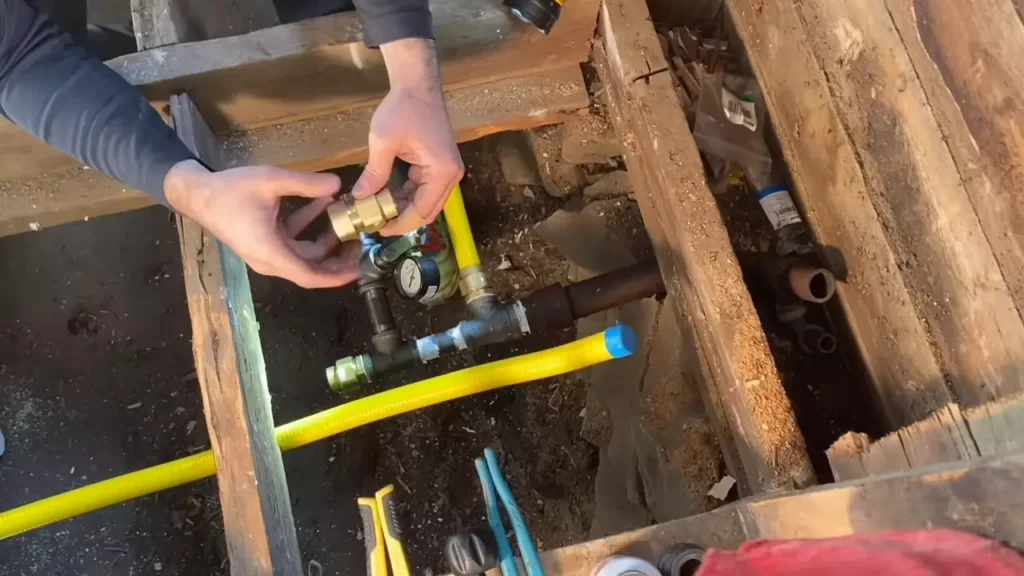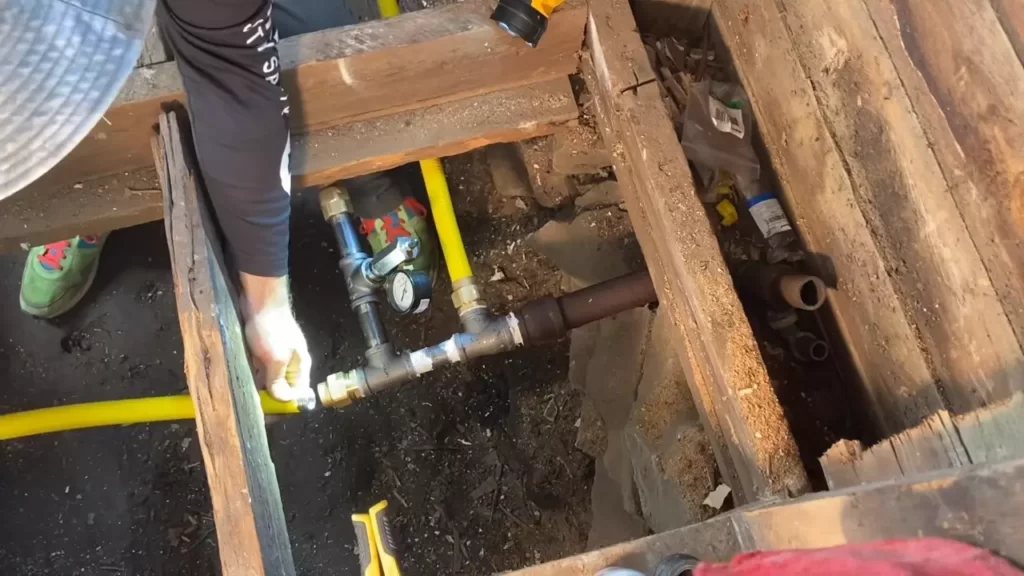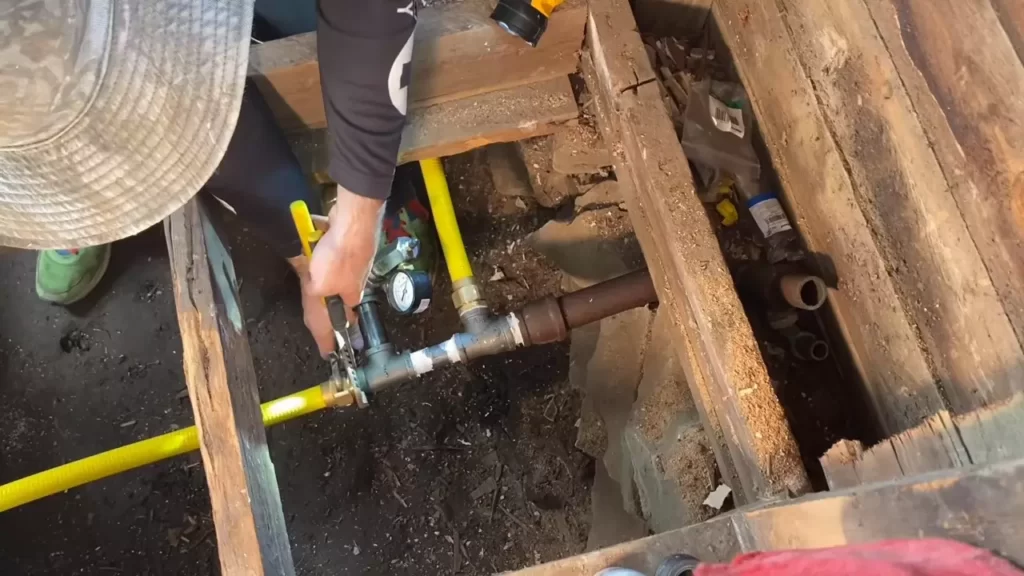To install a CSST gas line, follow these steps: ensure proper ventilation, turn off the gas supply, measure and cut the CSST tubing, attach fittings, connect the tubing to the gas source and appliances, and perform a leak test. Installing a CSST gas line requires careful attention to safety precautions and following local building codes.
It is important to have a good understanding of the installation process or consult a professional gas line installer. By following the steps outlined in this guide, you can safely and effectively install a CSST gas line for your home or business.

Understanding Csst Gas Lines
What is CSST?
CSST, which stands for Corrugated Stainless Steel Tubing, is a flexible and durable material used for gas piping systems. It is a popular choice for residential and commercial applications due to its numerous benefits and ease of installation.
Advantages of CSST Gas Lines
There are several advantages of using CSST gas lines over traditional rigid pipe systems:
- Flexibility: CSST can be easily bent and routed around obstacles, making it ideal for installation in tight spaces.
- Efficiency: The smooth interior surface of CSST allows for efficient gas flow, minimizing pressure drops and improving system performance.
- Corrosion Resistance: CSST is made from stainless steel, which is highly resistant to corrosion. This ensures the longevity and durability of the gas piping system.
- Lightweight: CSST weighs significantly less than traditional rigid pipes, making it easier to handle and transport.
- Reduced Labor and Material Costs: The flexibility and ease of installation of CSST result in reduced labor and material costs, making it a cost-effective choice for gas piping projects.
When to Use CSST Gas Lines
CSST gas lines are commonly used in residential and commercial applications where flexibility and ease of installation are desired. They are perfect for gas piping projects in:
- Residential homes
- Commercial buildings
- Renovation projects
- New Construction
It is important to note that CSST gas lines should be installed by qualified professionals who are trained in handling and installing CSST. Compliance with local codes and regulations is vital to ensure the safety and reliability of the gas piping system.

Safety Considerations For Installing Csst Gas Lines
When it comes to installing CSST gas lines, it is imperative to prioritize safety at every step of the process. Installing these gas lines requires careful attention to safety codes and regulations, proper handling and storage techniques, as well as the use of specific safety equipment and precautions. In this section, we will delve deeper into the various safety considerations that should be taken into account when installing CSST gas lines.
Familiarizing Yourself with Safety Codes and Regulations
Before beginning the installation process, it is crucial to familiarize yourself with the relevant safety codes and regulations pertaining to CSST gas lines. These codes and regulations are designed to ensure the safe installation and use of CSST gas lines, thereby reducing the risk of gas leaks and other hazardous situations.
To adhere to these safety codes and regulations, it is recommended to consult the local building department or the National Fire Protection Association (NFPA) for specific guidelines. Additionally, it is essential to stay updated with any revisions or amendments to these codes.
Proper Handling and Storage of CSST Gas Lines
Proper handling and storage of CSST gas lines are paramount to maintaining their integrity and preventing any potential damage or accidents. Consider the following best practices for handling and storing CSST gas lines:
- Handle with Care: CSST is a flexible material that can be vulnerable to damage. Avoid bending or crimping the gas lines excessively, as this can compromise their structural integrity and lead to leaks.
- Avoid Sharp Objects: When handling CSST gas lines, ensure that they are not in contact with any sharp objects or surfaces that could cause punctures or abrasions.
- Protect from Impact: Take precautions to protect the CSST gas lines from any potential impact or damage during transport, storage, and installation. This can be achieved by using appropriate padding or wrapping materials.
- Store in a Dry Environment: CSST gas lines should be stored in a cool, dry location to prevent any moisture buildup or corrosion. Avoid storing them near any heat sources or direct sunlight that could cause damage.
Required Safety Equipment and Precautions
To ensure a safe installation process, it is necessary to have the following safety equipment on hand:
- Protective Gear: Wear protective gloves, safety glasses, and appropriate clothing to safeguard your body from potential hazards.
- Gas Leak Detection Solution: Use a gas leak detection solution to check for leaks in the CSST gas lines during and after installation. This solution can help identify even the slightest leak by producing bubbles when applied to the gas line connections.
- Fire Extinguisher: Keep a fire extinguisher nearby in case of any unforeseen emergencies or accidents.
- Proper Ventilation: Ensure there is adequate ventilation in the installation area to prevent the accumulation of gas and reduce the risk of combustion.
- Test and Inspect: Before completing the installation process, it is crucial to test and inspect the CSST gas lines for leaks. Conduct a pressure test and carefully examine all connections and fittings for any signs of leakage.
By adhering to safety codes and regulations, handling and storing CSST gas lines properly, as well as using the necessary safety equipment and precautions, you can ensure a secure and efficient installation of CSST gas lines. Keeping safety at the forefront throughout the entire installation process is vital to protect not only yourself but also the occupants of the property and the surrounding environment.

Step-By-Step Guide To Installing Csst Gas Lines
Planning the installation
Before you begin installing CSST gas lines, it’s important to plan out the installation process to ensure a smooth and safe installation. Start by identifying the appliances that will be connected to the gas line and determine the appropriate route for the CSST. Take into consideration any obstacles, such as walls or obstructions, and make sure there is proper ventilation in the area.
Once you have a clear plan, gather all the necessary tools and materials required for the installation. This may include CSST tubing, fittings, connectors, gas shut-off valves, and protective sleeves.
Choosing the right CSST gas line materials
When selecting CSST gas line materials, it’s crucial to choose high-quality and certified products that comply with industry standards. Look for CSST tubing that is flexible, corrosion-resistant, and designed for gas applications. Additionally, ensure that the fittings and connectors are compatible with the specific CSST tubing being used.
By using reliable materials, you can ensure the longevity and safety of your CSST gas line installation.
Measuring and cutting CSST gas lines
Accurate measurements are essential when installing CSST gas lines. Begin by measuring the distance from the gas source to each appliance, ensuring you have enough tubing to reach each point. Use a proper tool, such as a tubing cutter, to cut the CSST tubing to the required lengths.
Remember to follow the manufacturer’s guidelines for cutting CSST tubing to avoid any irregularities that may compromise the installation.
Installing fittings and connectors
Once the CSST gas lines are cut to the appropriate lengths, it’s time to install the fittings and connectors. Start by attaching the fittings securely to each end of the CSST tubing, making sure they are properly aligned and tightened.
Ensure that the fittings and connectors are leak-proof by applying an approved sealant or thread tape to the threaded portions. This will help prevent any gas leaks and ensure the integrity of the installation.
Securing the CSST gas lines
After the fittings and connectors are in place, it’s important to secure the CSST gas lines properly. Use the recommended straps or brackets provided by the manufacturer to secure the tubing along the designated route. This will prevent any movement or potential damage to the CSST gas lines.
Make sure to follow the spacing requirements and secure the CSST gas lines at regular intervals to maintain structural integrity.
Testing for leaks
Prior to finalizing the installation, it’s crucial to test the CSST gas lines for any potential leaks. Apply a suitable leak detection solution or use a gas detector around each fitting and connection point.
Observe for any signs of bubbles or gas detection. If there are no leaks detected, proceed with the next step. However, if there is a leak, immediately shut off the gas supply, identify the source of the leak, and rectify the problem before proceeding.
Finalizing the installation
With the CSST gas lines properly installed and tested for leaks, it’s time to finalize the installation. Double-check all the fittings, connections, and tubing to ensure everything is securely in place.
Once you’re confident in the integrity of the installation, turn on the gas supply and check for any additional leaks. Take note of the gas pressure and ensure it falls within the recommended range.
Finally, organize and label the CSST gas lines for easy identification in the future, and keep all documentation related to the installation for future reference.
Frequently Asked Questions On How To Install Csst Gas Line
Is Csst Better Than Black Pipe?
CSST is often preferred over black pipe because it is more flexible, easier to install, and can reduce labor costs. It also has a lower risk of leaks and is resistant to corrosion. However, it is important to follow local codes and regulations to ensure proper installation and safety.
Do You Have To Ground Csst Gas Line?
Yes, it is necessary to ground CSST gas lines. Grounding helps reduce the risk of fire or explosion caused by lightning strikes or electrical currents. By grounding the CSST gas line, you can ensure the safety of your home and prevent potential hazards.
Can You Run Csst Inside A Wall?
Yes, you can run CSST inside a wall as long as it is properly installed and meets building code requirements.
Where Are Csst Lines Supposed To Be Grounded?
CSST lines are required to be properly grounded. The specific grounding requirements for CSST lines depend on local building codes and regulations. It is recommended to consult with a professional electrician or plumber to ensure compliance and safety.
Conclusion
Installing a CSST gas line is a crucial task that requires precision and knowledge. By following the steps outlined in this blog post, you can ensure a safe and efficient installation process. Remember to always prioritize safety, use the right tools and materials, and consult professional help if needed.
So go ahead, take the necessary precautions, and enjoy the convenience and benefits of a properly installed CSST gas line. Happy installing!
